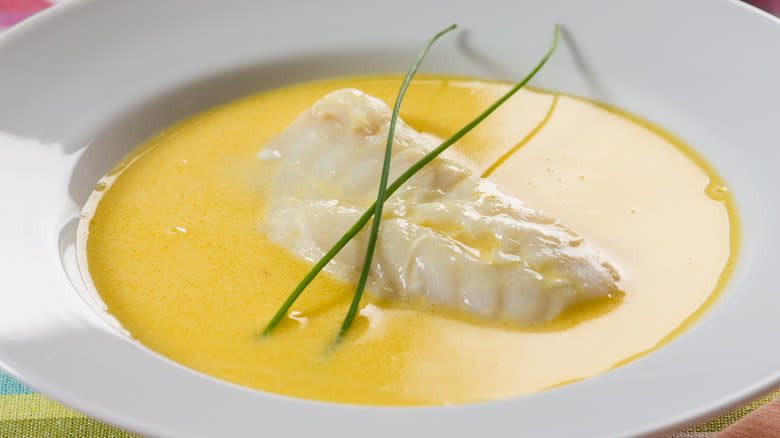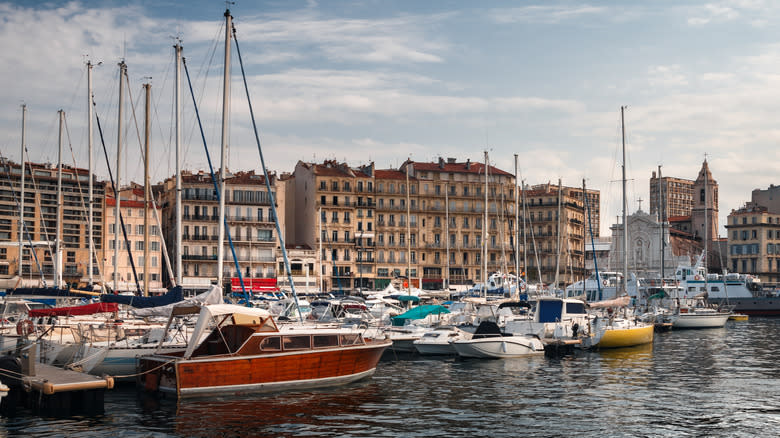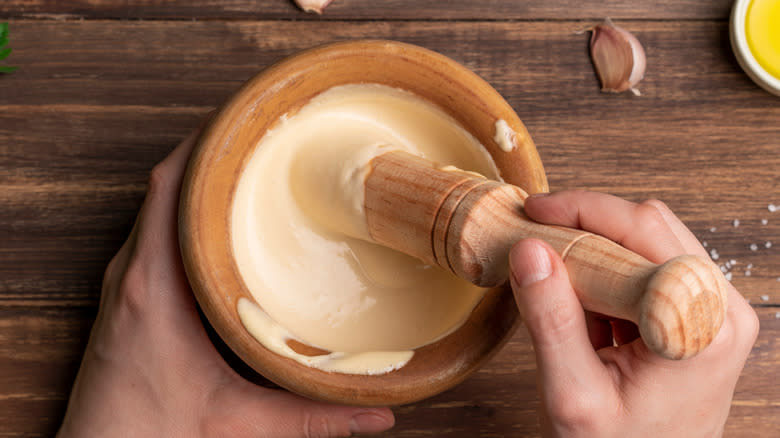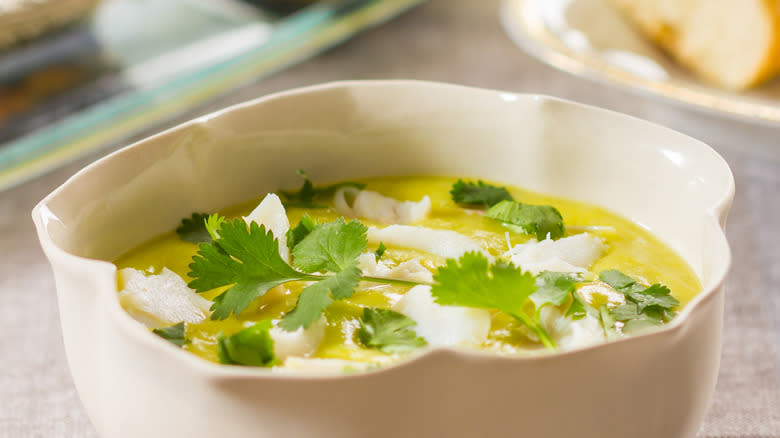Bourride Is The French Fish Stew Featuring Aioli As A Star Ingredient

Sunny Provence in the south of France is home to some of the country's most iconic foods. From this region of palm trees and dramatic coastlines come celebrated rosé wines, bouillabaisse, tapenade, ratatouille, and, that wonderfully garlicky infusion, aioli. It's this last sauce that plays an important role in one of the area's lesser-known fish stews. It's called bourride, and it is a dish worth seeking out for anyone who loves Provençal cuisine.
Only similar to its relative, bouillabaisse, in that it is fish stew, bourride is heartier, simpler to make, and, in many ways, less glamorous. Bourride is not traditionally made with expensive shellfish, but instead with white fish that populate the Mediterranean Sea. Provence makes up much of France's southern border with the Med. The cuisine that comes from this area of the world is known for its emphasis on vegetables, olive oil, and seafood. Bourride fits right into that Med-diet mold.
The stew has two specifically Provençal ingredients that the more well-known bouillabaisse does not: monkfish, and our old friend, aioli. Without at least one of these two ingredients, the stew cannot be considered bourride. This staple fisherman's stew, as you'll find, has a fascinating history, and is easy to put together if you have the right ingredients.
Read more: 15 Different Ways To Cook Fish
A Fishy History

The famous fish soups and stews of southern France are the inventions of those who make a living on the sea. They typically developed from any fish that wouldn't sell, along with the bones, head, and tails of the parceled-out fish. These were used to make a rich broth that was often thickened with eggs, olive oil, or aioli. Bourride comes out of this tradition.
Though the exact date of its invention is not known, it is safe to guess that bourride has been around for centuries. Actually originating from the town of Sète, just west of Provence on the south coast, local legend states that the soup was so delicious it was fit for the Olympian gods.
The full title of the soup, bourride de baudroie, names an essential ingredient. Baudroie is Provençal for monkfish. The monkfish — a terrifying-looking but very flavorful fish — is paired with leeks, potatoes, onions, and garlic, and served in that rich fish broth.
Rustic bread, toasted or fried with olive oil is served with the soup. This is where the aioli comes in for the traditional bourride recipe: The thick sauce is spread on the toast. Bourride is not heavily flavored with herbs and spices, though pinches of saffron are used on occasion.
Aioli As The Star

The version of bourride we've discussed so far has been the traditional, monkfish-centric kind from Sète. However, as the soup is indicative of the whole of the Provence coast, many more fish have found their way into the recipe. Halibut, as well as shellfish like clams and shrimp, are common additions. White wine is also used to bring extra flavor, and fresh parsley can be used as a garnish or as part of the stock. This version of bourride is more common in Marseilles, which is often associated with bourride.
Then we come to the aioli, which can be used in different ways to flavor this stew. For anyone unfamiliar, aioli is a simple garlic sauce that is made by emulsifying together minced garlic, egg yolk, lemon juice, salt, and olive oil. The result is mayonnaise-like in its consistency, with a distinct garlic taste. In the Marseilles recipe, the aioli is whisked into the broth at the very end of the recipe, as opposed to just spread over bread or toast. The aioli is added late so as not to impart too much of its strong garlic flavor onto the delicate fish.
Depending on how much garlic you like, you can always adjust the amount of aioli that goes into the finished broth. You should add enough so that its presence is known, but not so much that the flavor of the fish is overpowered.
How To Make Bourride

There are a couple of different ways to make bourride. If you're a stickler for tradition, and want to make it the way it's been made in Sète for hundreds of years, you will need to seek out a monkfish. These bottom-dwellers can be difficult to come by unless you live near where they are fished. The traditional recipe calls for a broth made from the monkfish remains, while the filets are baked in a garlic and olive oil sauce alongside the vegetables and herbs. The aioli is served on the side, with accompanying toasted French bread.
Other takes on the recipe add flavors like fennel, cayenne pepper, bay leaves, saffron, wine, and cream. These additions create a very flavorful and rich broth, in which the myriad fish are gently simmered for only a few minutes. Once cooked, the fish is removed from the broth while the aioli is added in. It is first diluted in some of the broth, before being stirred back into the main body of the stew. Then aioli-infused broth is spooned over the fish, making for a hearty and flavorful stew.
While there are several unique adaptations of bourride, one thing remains consistent: It is more affordable and less complicated than bouillabaisse. So, if you'd like to do a bit of Provençal cooking, you're definitely going to want to give bourride a try.
Read the original article on Tasting Table.

